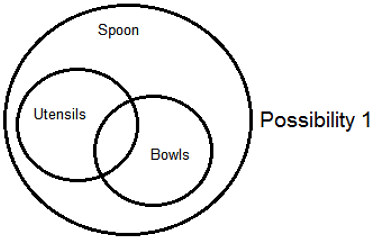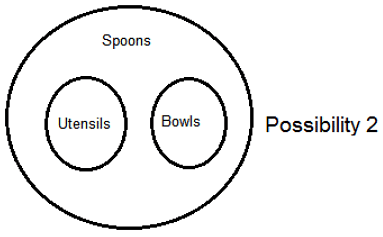CLAT Exam > CLAT Questions > Directions: Two statements are given followe...
Start Learning for Free
Directions: Two statements are given followed by three conclusions numbered I, II and III. Assuming the statements to be true, even if they seem to be at variance with commonly known facts, decide which of the conclusions logically follow(s) from the statements.
Statements:
All utensils are spoons.
All bowls are spoons.
Conclusions:
I. No utensil is a bowl.
II. Some utensils are bowls.
III. No spoons is a utensil.
- a)Only conclusions I follows
- b)Conclusions I and Ill follow.
- c)Either conclusion I or II follows.
- d)Only conclusion III follows.
Correct answer is option 'C'. Can you explain this answer?
Most Upvoted Answer
Directions: Two statements are given followed by three conclusions nu...
According to question



If possibility 1 follows, possibility 2 will be crossed and if possibility 2 follows, possibility 1 will be crossed.
So, either conclusion I or II follows.
Free Test
FREE
| Start Free Test |
Community Answer
Directions: Two statements are given followed by three conclusions nu...
Statements:
1. All utensils are spoons.
2. All bowls are spoons.
Conclusions:
I. No utensil is a bowl.
II. Some utensils are bowls.
III. No spoon is a utensil.
Explanation:
In order to determine which conclusions logically follow from the given statements, let's analyze each conclusion separately.
Conclusion I: No utensil is a bowl.
This conclusion cannot be logically derived from the given statements. The statements only indicate that all utensils are spoons and all bowls are spoons. It does not provide any information about the relationship between utensils and bowls. Therefore, we cannot conclude that no utensil is a bowl.
Conclusion II: Some utensils are bowls.
This conclusion can be logically derived from the given statements. Since all bowls are spoons and all utensils are spoons, it is possible for there to be some utensils that are also bowls. Therefore, conclusion II follows from the statements.
Conclusion III: No spoon is a utensil.
This conclusion cannot be logically derived from the given statements. The statements indicate that all utensils are spoons, which means that every utensil is a spoon. Therefore, we cannot conclude that no spoon is a utensil.
Based on the above analysis, only conclusion II (Some utensils are bowls) logically follows from the given statements. Therefore, the correct answer is option C (Either conclusion I or II follows).
1. All utensils are spoons.
2. All bowls are spoons.
Conclusions:
I. No utensil is a bowl.
II. Some utensils are bowls.
III. No spoon is a utensil.
Explanation:
In order to determine which conclusions logically follow from the given statements, let's analyze each conclusion separately.
Conclusion I: No utensil is a bowl.
This conclusion cannot be logically derived from the given statements. The statements only indicate that all utensils are spoons and all bowls are spoons. It does not provide any information about the relationship between utensils and bowls. Therefore, we cannot conclude that no utensil is a bowl.
Conclusion II: Some utensils are bowls.
This conclusion can be logically derived from the given statements. Since all bowls are spoons and all utensils are spoons, it is possible for there to be some utensils that are also bowls. Therefore, conclusion II follows from the statements.
Conclusion III: No spoon is a utensil.
This conclusion cannot be logically derived from the given statements. The statements indicate that all utensils are spoons, which means that every utensil is a spoon. Therefore, we cannot conclude that no spoon is a utensil.
Based on the above analysis, only conclusion II (Some utensils are bowls) logically follows from the given statements. Therefore, the correct answer is option C (Either conclusion I or II follows).

|
Explore Courses for CLAT exam
|

|
Similar CLAT Doubts
Directions: Two statements are given followed by three conclusions numbered I, II and III. Assuming the statements to be true, even if they seem to be at variance with commonly known facts, decide which of the conclusions logically follow(s) from the statements.Statements:All utensils are spoons.All bowls are spoons.Conclusions:I. No utensil is a bowl.II. Some utensils are bowls.III. No spoons is a utensil.a)Only conclusions I followsb)Conclusions I and Ill follow.c)Either conclusion I or II follows.d)Only conclusion III follows.Correct answer is option 'C'. Can you explain this answer?
Question Description
Directions: Two statements are given followed by three conclusions numbered I, II and III. Assuming the statements to be true, even if they seem to be at variance with commonly known facts, decide which of the conclusions logically follow(s) from the statements.Statements:All utensils are spoons.All bowls are spoons.Conclusions:I. No utensil is a bowl.II. Some utensils are bowls.III. No spoons is a utensil.a)Only conclusions I followsb)Conclusions I and Ill follow.c)Either conclusion I or II follows.d)Only conclusion III follows.Correct answer is option 'C'. Can you explain this answer? for CLAT 2025 is part of CLAT preparation. The Question and answers have been prepared according to the CLAT exam syllabus. Information about Directions: Two statements are given followed by three conclusions numbered I, II and III. Assuming the statements to be true, even if they seem to be at variance with commonly known facts, decide which of the conclusions logically follow(s) from the statements.Statements:All utensils are spoons.All bowls are spoons.Conclusions:I. No utensil is a bowl.II. Some utensils are bowls.III. No spoons is a utensil.a)Only conclusions I followsb)Conclusions I and Ill follow.c)Either conclusion I or II follows.d)Only conclusion III follows.Correct answer is option 'C'. Can you explain this answer? covers all topics & solutions for CLAT 2025 Exam. Find important definitions, questions, meanings, examples, exercises and tests below for Directions: Two statements are given followed by three conclusions numbered I, II and III. Assuming the statements to be true, even if they seem to be at variance with commonly known facts, decide which of the conclusions logically follow(s) from the statements.Statements:All utensils are spoons.All bowls are spoons.Conclusions:I. No utensil is a bowl.II. Some utensils are bowls.III. No spoons is a utensil.a)Only conclusions I followsb)Conclusions I and Ill follow.c)Either conclusion I or II follows.d)Only conclusion III follows.Correct answer is option 'C'. Can you explain this answer?.
Directions: Two statements are given followed by three conclusions numbered I, II and III. Assuming the statements to be true, even if they seem to be at variance with commonly known facts, decide which of the conclusions logically follow(s) from the statements.Statements:All utensils are spoons.All bowls are spoons.Conclusions:I. No utensil is a bowl.II. Some utensils are bowls.III. No spoons is a utensil.a)Only conclusions I followsb)Conclusions I and Ill follow.c)Either conclusion I or II follows.d)Only conclusion III follows.Correct answer is option 'C'. Can you explain this answer? for CLAT 2025 is part of CLAT preparation. The Question and answers have been prepared according to the CLAT exam syllabus. Information about Directions: Two statements are given followed by three conclusions numbered I, II and III. Assuming the statements to be true, even if they seem to be at variance with commonly known facts, decide which of the conclusions logically follow(s) from the statements.Statements:All utensils are spoons.All bowls are spoons.Conclusions:I. No utensil is a bowl.II. Some utensils are bowls.III. No spoons is a utensil.a)Only conclusions I followsb)Conclusions I and Ill follow.c)Either conclusion I or II follows.d)Only conclusion III follows.Correct answer is option 'C'. Can you explain this answer? covers all topics & solutions for CLAT 2025 Exam. Find important definitions, questions, meanings, examples, exercises and tests below for Directions: Two statements are given followed by three conclusions numbered I, II and III. Assuming the statements to be true, even if they seem to be at variance with commonly known facts, decide which of the conclusions logically follow(s) from the statements.Statements:All utensils are spoons.All bowls are spoons.Conclusions:I. No utensil is a bowl.II. Some utensils are bowls.III. No spoons is a utensil.a)Only conclusions I followsb)Conclusions I and Ill follow.c)Either conclusion I or II follows.d)Only conclusion III follows.Correct answer is option 'C'. Can you explain this answer?.
Solutions for Directions: Two statements are given followed by three conclusions numbered I, II and III. Assuming the statements to be true, even if they seem to be at variance with commonly known facts, decide which of the conclusions logically follow(s) from the statements.Statements:All utensils are spoons.All bowls are spoons.Conclusions:I. No utensil is a bowl.II. Some utensils are bowls.III. No spoons is a utensil.a)Only conclusions I followsb)Conclusions I and Ill follow.c)Either conclusion I or II follows.d)Only conclusion III follows.Correct answer is option 'C'. Can you explain this answer? in English & in Hindi are available as part of our courses for CLAT.
Download more important topics, notes, lectures and mock test series for CLAT Exam by signing up for free.
Here you can find the meaning of Directions: Two statements are given followed by three conclusions numbered I, II and III. Assuming the statements to be true, even if they seem to be at variance with commonly known facts, decide which of the conclusions logically follow(s) from the statements.Statements:All utensils are spoons.All bowls are spoons.Conclusions:I. No utensil is a bowl.II. Some utensils are bowls.III. No spoons is a utensil.a)Only conclusions I followsb)Conclusions I and Ill follow.c)Either conclusion I or II follows.d)Only conclusion III follows.Correct answer is option 'C'. Can you explain this answer? defined & explained in the simplest way possible. Besides giving the explanation of
Directions: Two statements are given followed by three conclusions numbered I, II and III. Assuming the statements to be true, even if they seem to be at variance with commonly known facts, decide which of the conclusions logically follow(s) from the statements.Statements:All utensils are spoons.All bowls are spoons.Conclusions:I. No utensil is a bowl.II. Some utensils are bowls.III. No spoons is a utensil.a)Only conclusions I followsb)Conclusions I and Ill follow.c)Either conclusion I or II follows.d)Only conclusion III follows.Correct answer is option 'C'. Can you explain this answer?, a detailed solution for Directions: Two statements are given followed by three conclusions numbered I, II and III. Assuming the statements to be true, even if they seem to be at variance with commonly known facts, decide which of the conclusions logically follow(s) from the statements.Statements:All utensils are spoons.All bowls are spoons.Conclusions:I. No utensil is a bowl.II. Some utensils are bowls.III. No spoons is a utensil.a)Only conclusions I followsb)Conclusions I and Ill follow.c)Either conclusion I or II follows.d)Only conclusion III follows.Correct answer is option 'C'. Can you explain this answer? has been provided alongside types of Directions: Two statements are given followed by three conclusions numbered I, II and III. Assuming the statements to be true, even if they seem to be at variance with commonly known facts, decide which of the conclusions logically follow(s) from the statements.Statements:All utensils are spoons.All bowls are spoons.Conclusions:I. No utensil is a bowl.II. Some utensils are bowls.III. No spoons is a utensil.a)Only conclusions I followsb)Conclusions I and Ill follow.c)Either conclusion I or II follows.d)Only conclusion III follows.Correct answer is option 'C'. Can you explain this answer? theory, EduRev gives you an
ample number of questions to practice Directions: Two statements are given followed by three conclusions numbered I, II and III. Assuming the statements to be true, even if they seem to be at variance with commonly known facts, decide which of the conclusions logically follow(s) from the statements.Statements:All utensils are spoons.All bowls are spoons.Conclusions:I. No utensil is a bowl.II. Some utensils are bowls.III. No spoons is a utensil.a)Only conclusions I followsb)Conclusions I and Ill follow.c)Either conclusion I or II follows.d)Only conclusion III follows.Correct answer is option 'C'. Can you explain this answer? tests, examples and also practice CLAT tests.

|
Explore Courses for CLAT exam
|

|
Signup for Free!
Signup to see your scores go up within 7 days! Learn & Practice with 1000+ FREE Notes, Videos & Tests.


























